India Vs England 2nd Test Match
Cricket History in the Making: Shubman Gill’s Captaincy Debut Stuns England
In a remarkable display of skill and leadership, Shubman Gill has etched his name in the annals of cricket history at Edgbaston. The 25-year-old’s record-breaking 269 runs—the highest Test score ever by an Indian in England—has not only established his credentials as a formidable batsman but also as a captain with extraordinary potential. As India commands a dominant position in the second Test match, England finds itself reeling at 77 for 3, trailing by a staggering 510 runs after Day 2. But beyond the numbers lies a deeper narrative about the evolution of Test cricket itself, with Gill voicing concerns that the essence of the longest format is gradually diminishing due to softening Dukes balls and increasingly flat pitches.
England’s strategic missteps have only compounded their troubles. Coach Brendon McCullum has openly admitted they misjudged the conditions, wrongly anticipating that the pitch would improve for batting over the five days. This miscalculation, coupled with captain Ben Stokes’ ongoing struggles with the bat, has prompted a flurry of squad adjustments including the addition of seamer Gus Atkinson. As the cricket world now turns its attention to the upcoming clash at Lord’s, one question remains: Can England regroup and mount a comeback, or will Gill’s India continue their commanding march toward series victory? Join us as we delve into the fascinating dynamics of this riveting India vs England 2nd Test match, exploring Gill’s record-breaking performance, his debut as Test captain, England’s strategic challenges, and what lies ahead at the iconic Lord’s Cricket Ground.
Shubman Gill’s Record-Breaking Performance at Edgbaston
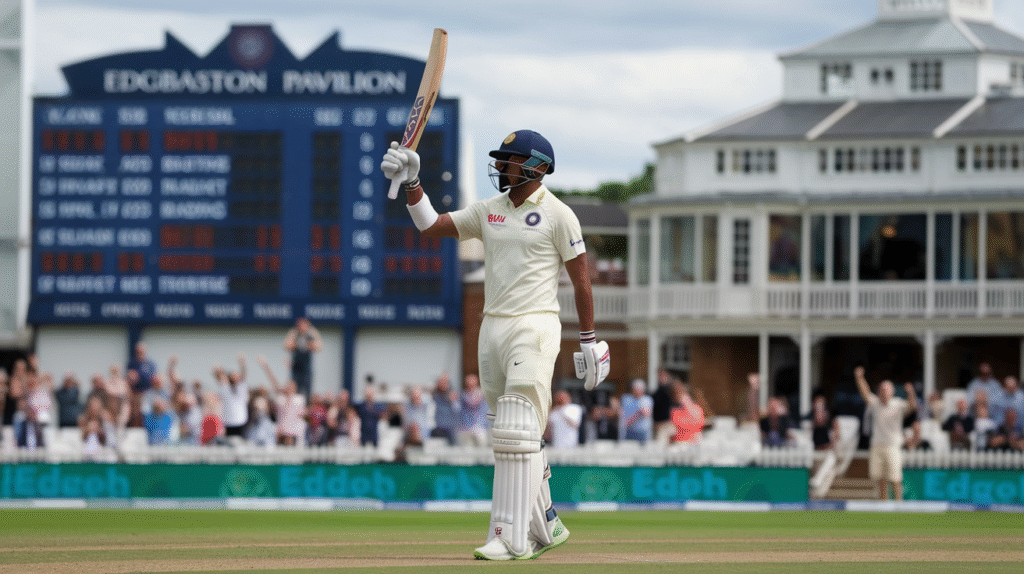
The second Test match at Edgbaston witnessed a historic performance from Shubman Gill, who etched his name in the annals of Indian cricket with a monumental innings. Taking on the responsibility of Test captaincy, Gill responded with a performance that broke multiple records and established new benchmarks for Indian batters in England.
Career-high 269 runs – the highest Test score by an Indian in England
Gill’s magnificent knock of 269 runs has rewritten the record books in several ways:
- It stands as the highest score by an Indian batter in England, surpassing previous benchmarks set by stalwarts of Indian cricket
- This innings now ranks as the third-highest score by an Indian in away Tests, behind only Virender Sehwag’s 309 and Rahul Dravid’s 270 (both achieved during India’s 2004 tour of Pakistan)
- Gill’s knock is the highest ever by an Indian captain in Test cricket, breaking the previous record held by Mohammad Azharuddin’s 179 from 1990
- At just 25 years and 298 days, Gill became the second-youngest Indian captain to score a double-century in Tests, following MAK Pataudi
- He joined an elite club as only the third Indian batter to achieve a double-century on English soil, alongside Sunil Gavaskar and Rahul Dravid
- This performance marks the seventh-highest score by an Indian batter in Test cricket history
- Most significantly, Gill’s 269 is now the highest score by an Indian batter outside Asia, breaking Sachin Tendulkar’s previous record of 241 at the SCG in 2004
During this remarkable innings, Gill also reached several personal milestones, crossing 1,000 runs in away Tests with an impressive average of 42.92 and reaching 5,000 runs in First-Class cricket in his 63rd match.
Key partnerships with Jadeja (203 runs) and Sundar (144 runs)
What made Gill’s innings even more valuable was how he constructed it through crucial partnerships that helped India build their commanding total of 587:
- Gill formed a match-defining 203-run partnership with Ravindra Jadeja, who contributed a solid 89 runs to the stand
- This partnership proved pivotal in steering India away from early dangers and establishing dominance in the match
- Following Jadeja’s dismissal, Gill continued his masterclass by forging another substantial partnership of 144 runs with Washington Sundar
- These two partnerships formed the backbone of India’s innings, allowing them to post an imposing total that put enormous pressure on the English batting lineup
Gill’s exceptional control percentage throughout his innings highlighted his technical prowess and mental fortitude, especially considering the pressure of captaining the side in just his second Test match as skipper.
With Gill’s record-breaking performance setting the tone, let’s now examine how this extraordinary batting display contributed to India’s commanding position in the Second Test and how it put England on the back foot in their pursuit to maintain their series lead.
India’s Commanding Position in the Second Test
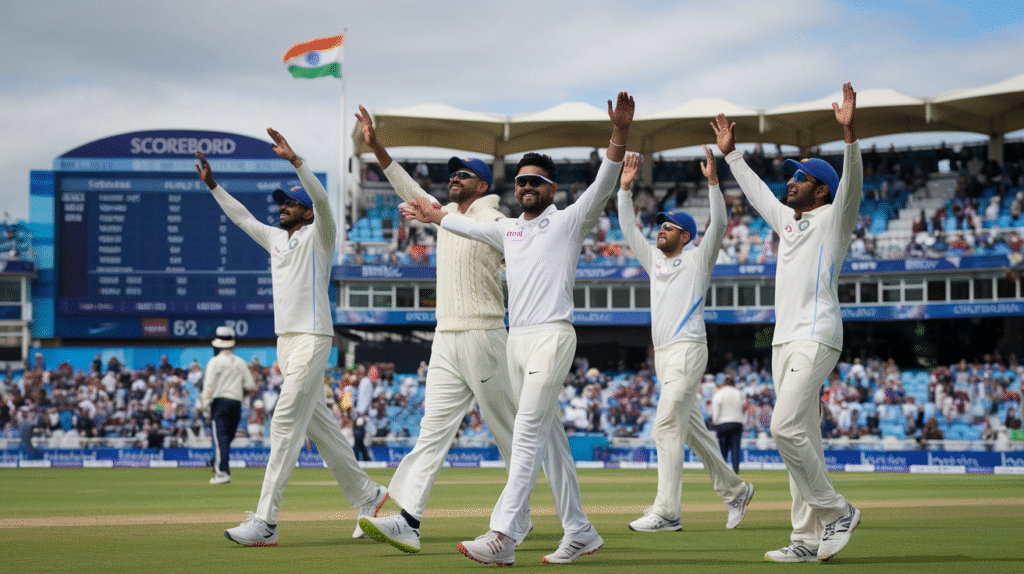
Building on Shubman Gill’s historic 269-run innings, India established an overwhelming advantage in the second Test at Edgbaston, creating the foundation for their eventual 336-run victory that leveled the series at 1-1.
Team’s impressive total of 587 runs before declaration
India’s dominance began with their monumental first-innings total of 587 runs, compiled over 151 overs. This imposing score was anchored by Gill’s record-breaking performance, which rescued India from a precarious position at 211/5. His partnerships proved crucial – a 203-run stand with Ravindra Jadeja (89) for the sixth wicket and another 144 runs with Washington Sundar (42) for the seventh wicket. These collaborations transformed India’s innings from challenging to commanding, pushing their total to just shy of 600 runs. England’s bowling attack struggled throughout, with Shoaib Bashir being their most effective bowler, claiming 3 wickets for 167 runs.
Akash Deep’s remarkable bowling performance including early wickets
When England came to bat, they faced the relentless precision of Akash Deep, who emerged as India’s bowling hero. He systematically dismantled England’s batting lineup, claiming six wickets for 99 runs in the first innings. Deep’s performance continued throughout the match, as he finished with an impressive ten-wicket haul. His ability to take early wickets put immediate pressure on England, setting the tone for India’s bowling dominance and preventing the hosts from establishing any meaningful resistance in their response.
England’s struggling response at 77 for 3, trailing by 510 runs
Facing India’s massive first-innings total, England’s batting faltered dramatically. They were reduced to 77 for 3, trailing by an enormous 510 runs. Though Jamie Smith offered commendable resistance with 88 runs, England ultimately managed only 407 in their first innings. Their struggles were further compounded by rain that reduced their survival target to 80 overs on the final day. Captain Ben Stokes later acknowledged critical missed opportunities, particularly when India was at 200-5, which could have changed the match’s trajectory. England’s inability to capitalize on these moments proved decisive in their downfall.
With India’s commanding position firmly established in this Test match, attention now turns to Gill’s leadership as captain. His debut in this role has been nothing short of exceptional, not only through his record-setting batting performance but also in how he has managed his team’s response after their defeat in the first Test.
Gill’s Debut as Test Captain
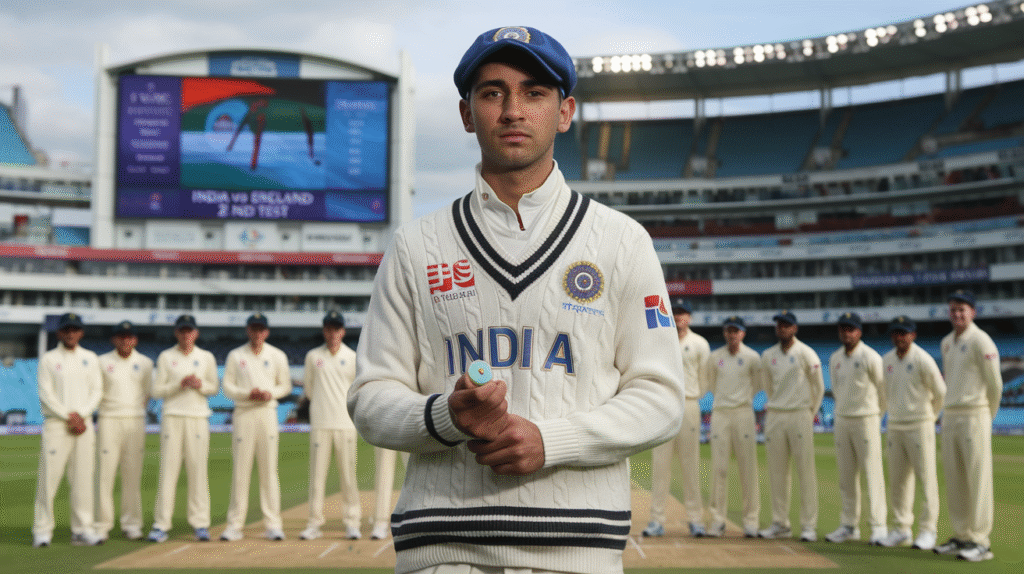
Now that we have examined India’s commanding position in the second Test, it’s worth highlighting the significant milestone this match represents for Shubman Gill. At just 25 years old, Gill has made history as India’s 37th Test captain, taking over the reins following Rohit Sharma’s retirement. This Edgbaston Test marks his captaincy debut in the longest format of the game, adding another achievement to his already impressive cricketing resume.
First win as captain marked by taking the match-winning catch
In a moment that will be etched in cricketing history, Gill’s debut as Test captain culminated in a dramatic fashion when he took the match-winning catch to seal India’s victory. This symbolic moment perfectly encapsulated his leadership journey – stepping up to secure the crucial final dismissal that handed India their first win of the five-Test series against England. The catch not only secured the victory but also provided a fitting conclusion to Gill’s maiden Test as captain, demonstrating his ability to contribute decisively in pressure situations.
Leadership credentials established in Virat Kohli’s absence
With the absence of experienced players like Virat Kohli, Gill has quickly established his leadership credentials in this second Test. The decision to appoint Gill as captain came after extensive discussions among selectors and coaching staff, who opted for him despite his relatively limited captaincy experience. Chief selector Ajit Agarkar emphasized that this appointment represents a long-term investment in Gill’s leadership for the future of Indian cricket.
Gill’s leadership approach has been particularly impressive given the challenges he faces – leading a young batting lineup and a relatively inexperienced bowling attack. Often nicknamed ‘Prince’ and compared to former Indian greats, Gill has embraced the responsibility of guiding a team in transition. While his Test performance statistics (1,893 runs in 32 matches prior to this series) had not yet reached the heights expected of his talent, his captaincy debut at Edgbaston has showcased his potential to combine batting prowess with tactical acumen.
With England’s strategic missteps becoming increasingly evident throughout this Test match, Gill’s captaincy has provided a stark contrast in leadership styles on display at Edgbaston.
England’s Strategic Missteps and Squad Adjustments
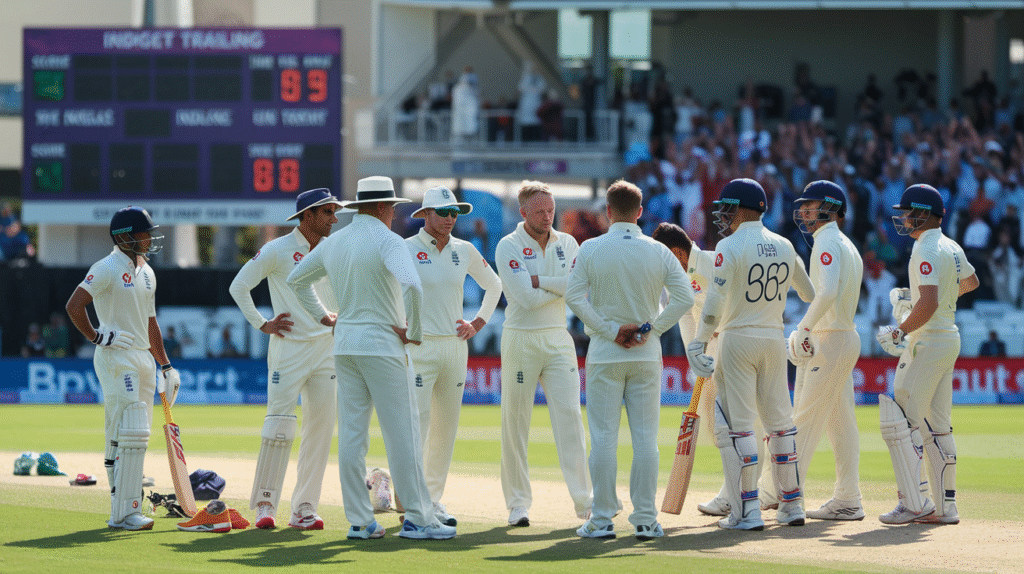
Now that we’ve explored Shubman Gill’s impressive debut as Test captain, it’s worth examining how England’s approach has faltered in this crucial second Test match at Edgbaston.
Brendon McCullum acknowledging misjudgment of pitch conditions
The “Bazball” approach that has defined England’s cricket under captain Ben Stokes and coach Brendon McCullum faced a significant challenge in the second Test against India. Despite England’s previous success with their aggressive batting strategy in home Tests, their performance analysis reveals a critical misjudgment of pitch conditions at Edgbaston.
McCullum has reportedly acknowledged that the team’s assessment of how the pitch would behave was flawed, particularly in understanding how the Dukes ball would perform on this surface. While England’s strategy typically relies on exploiting the Dukes ball’s swing capabilities, India’s bowlers outperformed England with high-seam deliveries during the match, taking full advantage of the pitch conditions that England’s management had misread.
Addition of Gus Atkinson as seam-bowling alternative
In response to their bowling weaknesses exposed in the second Test, England has made tactical squad adjustments by adding Gus Atkinson as a seam-bowling alternative. This move acknowledges the team’s need for more diverse bowling options, especially given the challenges posed by the Dukes ball in English conditions.
The Dukes ball, with its hand-stitched construction and pronounced seam, typically offers significant swing and seam movement that English bowlers have historically exploited to their advantage. However, without proper seam-bowling depth, England struggled to contain India’s commanding batting performance, leading to their 336-run defeat as highlighted in the match results.
Ben Stokes’ batting struggles affecting team performance
Captain Ben Stokes’ personal batting form has become a concern that’s affecting overall team dynamics. As the architect of the “Bazball” philosophy that prioritizes aggressive batting and risk-taking, Stokes’ inability to lead by example with the bat has created a disconnect between strategy and execution.
The analysis of England’s recent performances shows that while their scoring rates remain impressive compared to opponents, the absence of consistent contributions from key players like Stokes has undermined their aggressive approach. His struggles reflect broader challenges in maintaining the high-risk, high-reward style without the batting depth to sustain it through difficult phases of play.
Looking ahead to Lord’s for the third Test, England will need to reassess not only their tactical approach but also how they adapt their “Bazball” philosophy to different pitch conditions and opposition strengths.
Looking Ahead to Lord’s

Having examined England’s strategic missteps in the second Test at Edgbaston, which resulted in India’s commanding 336-run victory, all eyes now turn to the upcoming match at Lord’s. With India taking a strong position in the series, both teams are making key adjustments as they prepare for this crucial encounter.
England’s squad expansion with Jofra Archer, Sam Cook, and Jamie Overton
In response to their performance issues at Edgbaston, England has significantly bolstered their squad options for the Lord’s Test. The team has expanded their 16-man lineup with several notable additions to their bowling attack. Gus Atkinson has been brought in as a potential seam-bowling alternative, joining the returning Jofra Archer, Sam Cook, and Jamie Overton.
These additions reflect England’s recognition that they misjudged the conditions in the second Test, as coach Brendon McCullum admitted. McCullum acknowledged that the team had anticipated the pitch would improve for batting over the five days of play, which ultimately did not happen. With captain Ben Stokes struggling with the bat and highlighting the team’s overall lack of form, these squad adjustments signal England’s determination to correct their strategy before the Lord’s Test.
India’s bowling strength with Akash Deep and Mohammed Siraj
While England regroups, India heads to Lord’s with considerable bowling momentum. The Indian attack has proven formidable, contributing significantly to their dominant position in the series. Mohammed Siraj has been particularly effective, forming a crucial part of India’s bowling strategy that overwhelmed England at Edgbaston.
Akash Deep represents another valuable option in India’s seam bowling arsenal as they look to maintain their advantage. India’s captain Shubman Gill has expressed concerns about Test cricket’s changing nature, specifically mentioning the Dukes ball losing its hardness and flat pitches. Despite these concerns, India’s bowlers have adapted admirably, finding ways to remain effective even when conditions aren’t ideal for bowling.
Key player matchups that could determine the series outcome
As the teams prepare for the third Test of the five-match series scheduled from July 10-14 at Lord’s, several critical player matchups could prove decisive for the series outcome.
The struggle of England captain Ben Stokes with the bat will be under intense scrutiny, especially against India’s in-form bowlers. His ability to regain form could be pivotal to England’s chances of mounting a comeback in the series.
On the Indian side, Shubman Gill’s continued leadership as Test captain will be fascinating to watch. His record-breaking performance at Edgbaston has set a high standard, and how he handles the pressure at the historic Lord’s venue could significantly influence India’s prospects.
The battle between England’s expanded bowling attack and India’s confident batting lineup presents another fascinating dimension. With England adding firepower through Archer, Cook, and Overton, they clearly aim to challenge India’s batting dominance established in the opening Tests of this 2025 tour.
Conclusion
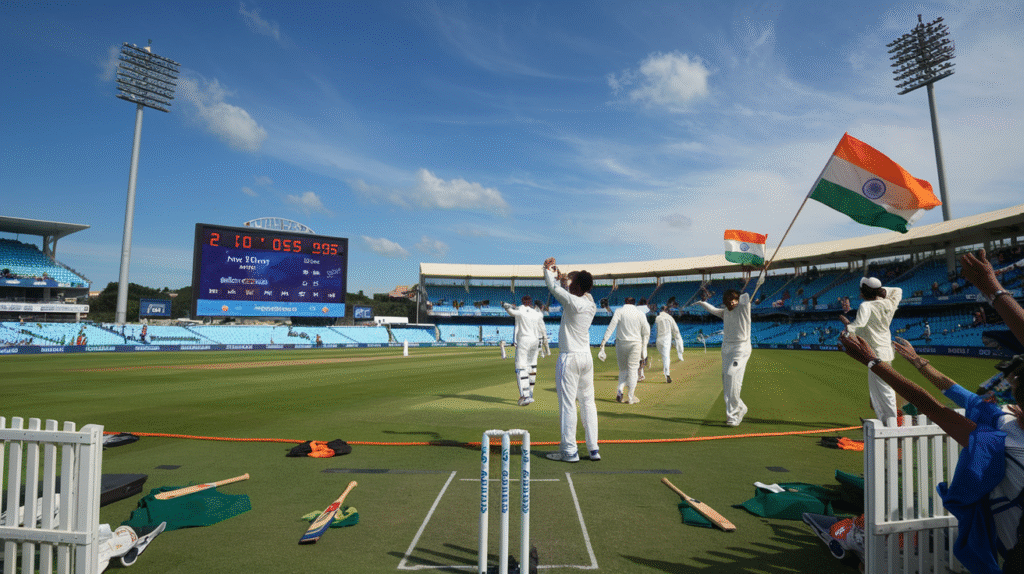
The 2nd Test match between India and England at Edgbaston has truly been a showcase of cricket at its finest, with Shubman Gill etching his name in the history books. His record-breaking 269 runs—the highest Test score by an Indian in England—along with his strategic partnerships with Jadeja and Sundar, demonstrated not just his batting prowess but his leadership capabilities. As he steps into his role as Test captain, Gill has already made a significant impact, taking the match-winning catch and leading India to a commanding position in the series.
England’s misjudgment of pitch conditions, as admitted by coach Brendon McCullum, proved costly as they now look to regroup for the upcoming Lord’s Test. The addition of Gus Atkinson to their squad signals their intent to strengthen their seam-bowling options, while questions surrounding Ben Stokes’ batting form remain a concern. As cricket enthusiasts, we can look forward to another thrilling encounter at Lord’s, where India will aim to capitalize on their momentum and England will seek redemption on home soil. The unfolding drama of this series continues to exemplify the enduring appeal of Test cricket, despite Gill’s valid concerns about the softening Dukes ball and flat pitches potentially diminishing the game’s competitive edge.




